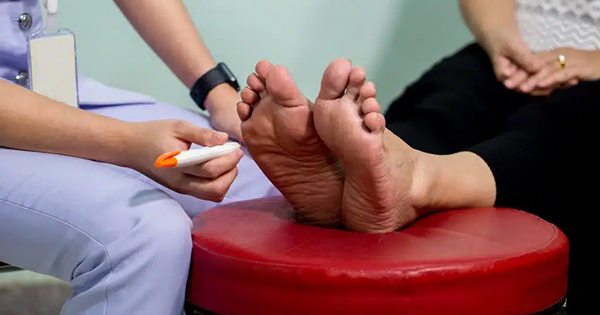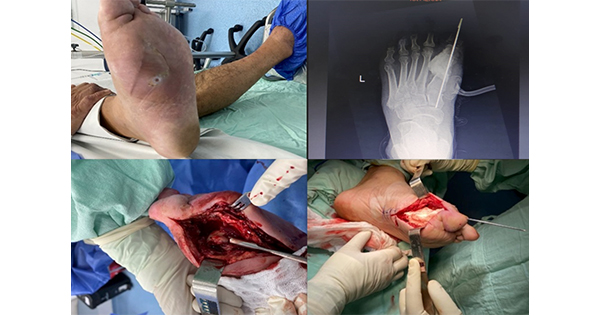The Network has had an impact with Foot Care Champions embedded across London determined and passionate to drive change. The London data evidences that there is widespread participation in foot MDTs and amputation rates are low across the sector. Despite this success, the Foot Care Network had failed to engage the Commissioners and therefore did not demonstrate sustainability within the healthcare system nor the ability to reduce variation across London.
An opportunity
The Network recognised that it could not aspire to excellence without the engagement of Commissioners who were able to hold organisations to account for delivery of patient care and innovation. A unique opportunity presented in 2016. With increasing awareness of the cost of Diabetic Foot Care, NHS England announced that it would be taking bids for transformation of Diabetes Services in England. A £44m transformation fund was made available for four areas of diabetes improvement; structured education, improving the achievement of the NICE recommended treatment targets, introducing new or expand multi-disciplinary footcare teams (MDFTs) as well as setting up or expanding diabetes inpatient specialist nursing services (DISNs).
The London Diabetes Clinical Network Footcare Steering Group agreed that a London-wide approach for MDFT transformation in London would be beneficial to the bidding process. It was recognised that service provision, location and distribution were different across the STP footprints and a ‘one size fits all’ model would not be appropriate. Therefore a programme of common themes, expenditure and outcome measures across the five London Sustainability and Transformation Plan (STP) Footprints was agreed. The basis of the programme was to ensure that patients with diabetes and acute foot pathology followed the correct pathways in a timely manner, seeing the right team at the right time. The National Diabetic Foot Audit had shown that delays in treatment by a specialist team leads to worse outcomes (amputations), increased hospitalisation and increased length of stay. Further data had shown up to 60% of admissions of the acute foot patient group occurred via A & E and that no London services had 7-day podiatry working.
It was agreed that the programme model for London should be based on:
Resourcing
It was agreed that supporting existing and new MDFTs was essential with the appointment of new podiatrists with administration, managerial and equipment within each STP. This was strengthened by aligning MDFTs and networking clinicians as part of the ‘vascular hub and spoke model’. The new podiatry posts would provide capacity to deliver new ‘hot clinics’ or similar ‘single points of contact’ for the STP footprint. The podiatrists would act as “Podiatry Pathfinders” diagnosing, treating and referring on to a suitable service whether admission to hospital (including repatriation to a local hospital), OPD care or returning to the High-Risk community service. Thenetworking of podiatry services within and across each STP and agreeing robust pathways and patient flows to and from the ‘single points of contact’ would reduce inequity of care provision across London and would raise the standard across London for example in access to orthotists, clinical psychology and OPAT.
Signposting
The London Foot Care Network had mapped care provision and capacity across London as well as the skill mix. It was recognised that resource was available across London but access to care was variable often due to the understanding and knowledge of the first point of access. The Network therefore agreed that single points of contact and signposting of existing pathways was essential to fast track patients to the appropriate care providers. This would involve open access to healthcare professionals to refer direct to the ‘single point of contact’ without the obstructing gateways that were currently in place in many sites. The hot clinic capacity would be available to A & E with direct podiatry liaison with Emergency Departments.
Access
The Network was aware that direct access to clinical psychology services would improve the outcomes for those patients with chronic or recurrent ulceration, long lengths of stay and amputation. The increased resource in Orthotics was also embedded in the Transformation Bids although it was recognised that there was variability in this resource across the STPs.
Common Outcome Measures
The London Network wished to develop common outcome measures across London so reducing variation in access and outcomes. These would include:
- Reduction in A & E attendances for Diabetic Foot complications
- Reduction in time to see a specialist acute foot team
- Reduced admissions for diabetic foot disease
- Reduced length of stay for patients with foot complications
- Reduced major amputations with a possible increase in minor foot amputations within 2 years.
The London Network were successful in gaining monies to fund the above. The funds were released in June 2017 and the STPs have recruited to all posts and have started to undertake baseline audits and calculations of current and new podiatry acute capacity.
The steering groups across four STPs have finalised the action plans and delivery times. But there is a difference in the steer from the Central Team. Rather than being driven by Clinicians alone, this time the Commissioners are at the table. The actions are time driven and are at the request of the Commissioners and change is being driven at pace.
Success will be judged on the delivery of the action plans, but patients are already reporting a difference. Lay members and patients who have been part of the steering group since the inception of the Network are evidencing change and the ease of access for patients with Foot Care complications.
How do Foot Champions utilise this focus and scrutiny from the Commissioners? Transformation monies have been invested within the UK and there is an ambition to improve healthcare by prevention rather than intervention. NHS Diabetes hosted the first National Foot Network meeting in 2013, challenging current practise and sharing innovation. The change of focus nationally halted this legacy and few Networks continued and those that did, forged ahead independently. If there is a desire to improve the outcomes for patients with diabetes and reduce foot complications, then this current unique opportunity should not be overlooked. The College of Podiatry and NHSE are keen to link the Networks and drive change at pace. With the additional support from the STP Commissioners, the first National Network event should take place in Spring 2019.
Within two years, the Transformation monies will cease, and the healthcare economy must be able to demonstrate that the cost savings developed can sustain the new posts and pathways for the benefit of patients in London and the UK. As the new Chairs for the Foot Care Workstream for London, with Commissioners, Patients and Providers driving change, we look forward to delivering this ask.




